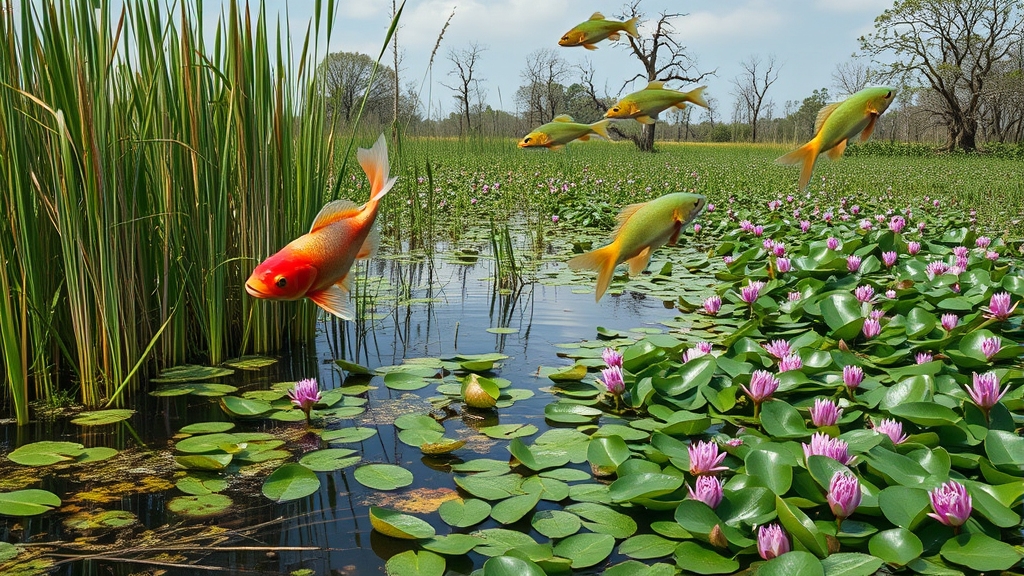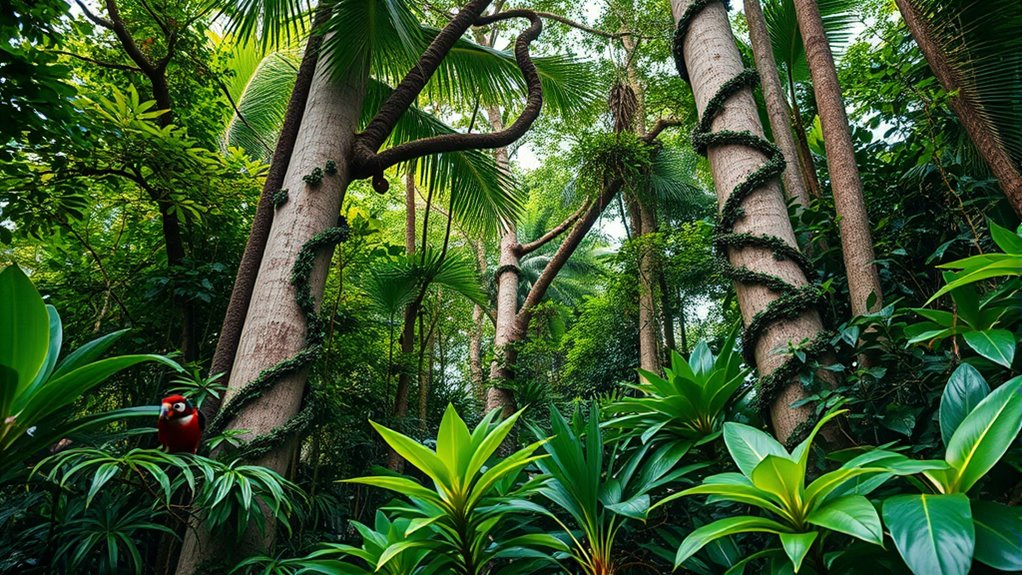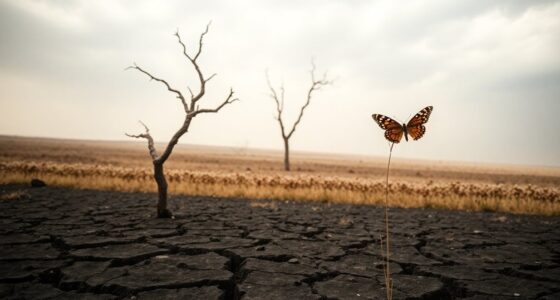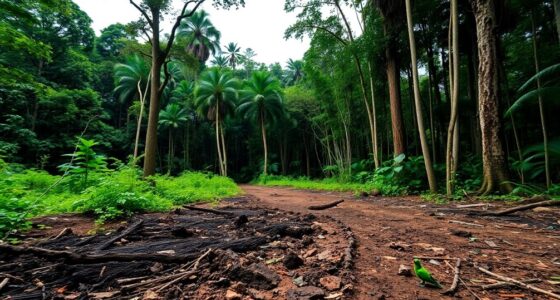Invasive species threaten biodiversity by outcompeting native plants and animals for resources, often forming dense monocultures that block sunlight and limit native growth. They can introduce new diseases, disrupting local ecosystems and causing native species to decline or disappear. Invasive plants also alter landscapes and waterways, making it harder for native species to survive. By understanding these impacts, you’ll see why managing invasive species is vital to protecting our ecosystems’ health and resilience.
Key Takeaways
- Invasive species outcompete native plants, leading to declines in native biodiversity and habitat loss.
- They form dense monocultures that reduce plant diversity and disrupt native pollinators.
- Invasive species introduce new diseases and parasites, harming native species and weakening ecosystems.
- They alter physical landscapes, impacting habitats and making it difficult for native species to survive.
- Managing invasive species is essential to protect native biodiversity and maintain ecosystem stability.

Invasive species pose a significant threat to biodiversity worldwide, often outcompeting native plants and animals for resources. When these non-native species establish themselves in new environments, they can dramatically alter the balance of local ecosystems. One of the most noticeable consequences is the decline of native plants, which struggle to survive as invasive species occupy their habitats, consume their resources, and sometimes even change the soil chemistry. As native plants decline, the animals that depend on them for food and shelter also face challenges, leading to a cascade of effects that ripple through the entire ecosystem.
You might not realize it, but when invasive species take hold, they cause significant ecosystem disruptions. These disruptions can manifest in various ways, from reducing the diversity of native flora and fauna to shifting nutrient cycling processes. For example, invasive plants often grow faster and more aggressively than native ones, forming dense monocultures that block sunlight and limit the growth of indigenous species. This not only diminishes plant diversity but also affects pollinators and herbivores that rely on native plants for sustenance. Over time, these changes weaken the resilience of the ecosystem, making it less capable of recovering from other stressors like climate change or human activity. Additionally, invasive species often have rapid reproductive rates, which enable them to quickly dominate new areas and make control efforts more challenging.
Invasive plants form monocultures, reducing biodiversity and weakening ecosystem resilience.
You’re also likely to notice that invasive species can introduce new diseases or parasites to native species, further threatening their survival. These invasive pathogens may have no natural enemies in the new environment, allowing them to spread unchecked and cause widespread illness among native populations. As native species decline or disappear, the ecological roles they played—such as seed dispersal, soil aeration, or pest control—are lost or diminished, resulting in further ecosystem disruptions. This loss of biodiversity not only reduces the natural beauty and complexity of habitats but also affects ecosystem services that humans rely on, such as clean water, fertile soil, and climate regulation.
Moreover, invasive species can alter the physical landscape, changing habitats in ways that make it difficult for native species to adapt or survive. They may modify waterways, soil composition, or vegetation structure, creating a new environment that favors their continued dominance. These changes can be difficult to reverse once established, emphasizing the importance of early detection and prevention. Additionally, understanding the role of native species in maintaining ecosystem stability highlights the importance of conservation efforts to protect these vital populations. By understanding how invasive species impact native plant populations and cause ecosystem disruptions, you can appreciate the urgent need for conservation efforts aimed at protecting native biodiversity and maintaining healthy, resilient ecosystems.
Furthermore, invasive species management is critical for restoring the health of affected ecosystems and preventing further loss of native species.
Frequently Asked Questions
How Do Invasive Species Spread Across Different Ecosystems?
You might wonder how invasive species spread across ecosystems. They disperse through various mechanisms like human activities, such as shipping and travel, which increase ecosystem connectivity. Natural processes like wind, water, and animal movement also aid their dispersal. As you observe these patterns, you realize that species dispersal often exploits existing pathways, allowing invasive species to quickly colonize new areas and disrupt native ecosystems.
What Are the Economic Impacts of Invasive Species on Local Communities?
You might not realize it, but invasive species can gently disrupt local economies. Their spread causes significant economic costs, affecting agriculture, fisheries, and tourism. These community impacts often lead to higher prices, job losses, and increased management expenses. While it’s a subtle challenge, addressing these invasive species helps protect your community’s financial health, ensuring that local resources remain sustainable and vibrant for everyone’s benefit.
Can Invasive Species Be Beneficial in Any Scenarios?
You might think invasive species are always harmful, but in some cases, they can create beneficial interactions. For example, controlled invasions can help restore ecological balance or support agriculture by controlling pests. In certain environments, invasive plants may provide food or habitat for native animals. While generally risky, these controlled scenarios show that invasive species can sometimes offer advantages, highlighting the importance of careful management and understanding ecological dynamics.
How Do Climate Change and Invasive Species Interact?
Climate change and invasive species interact in ways that threaten native species and hinder habitat restoration. As climate shifts, invasive species often adapt faster, outcompeting native species for resources. You might notice altered ecosystems where invasive plants or animals dominate, making habitat restoration difficult. This interaction accelerates biodiversity loss, as native species struggle to survive, and ecosystems become less resilient to environmental changes caused by climate change.
What Measures Are Most Effective for Controlling Invasive Populations?
Imagine battling an unwelcome guest invading your space. You can use biological control, introducing natural predators to curb their spread, or focus on habitat restoration to strengthen native species’ resilience. These measures work best when combined, creating a balanced approach. By targeting invasive populations directly and restoring ecosystems, you limit their reach and protect biodiversity. Staying vigilant and adaptive guarantees these efforts are most effective, keeping ecosystems healthy and diverse.
Conclusion
Invasive species can turn the tables on native ecosystems, often causing more harm than good. By unchecked spread, they threaten the rich tapestry of biodiversity you’re trying to protect. Remember, when invasive species take hold, it’s like opening a can of worms—things quickly spiral out of control. Stay vigilant and proactive, because once the damage is done, it’s tough to put the genie back in the bottle. Protecting native species keeps nature’s balance in check for future generations.









